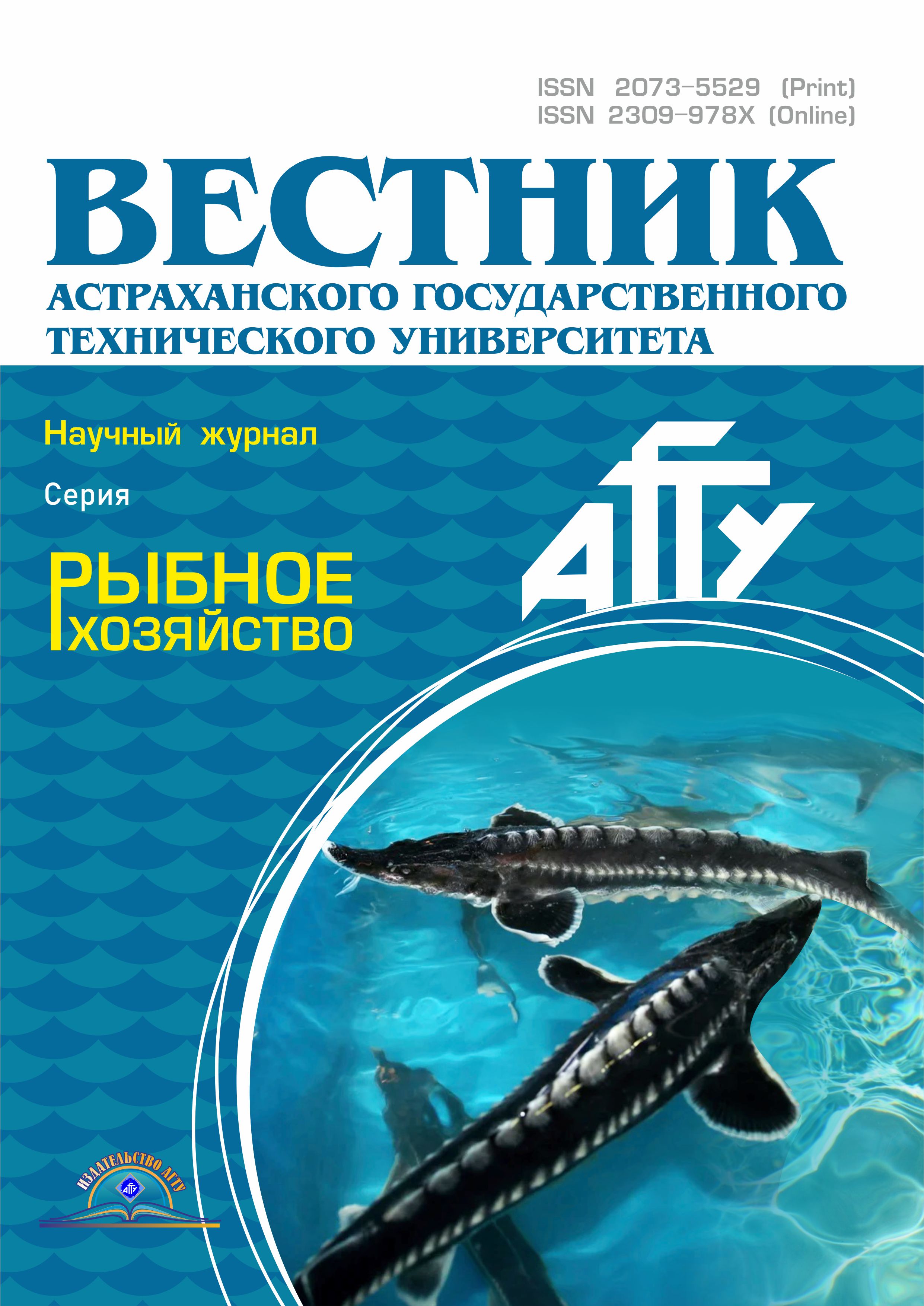CSCSTI 34.39
CSCSTI 62.13
CSCSTI 69.01
CSCSTI 69.25
CSCSTI 69.31
CSCSTI 69.51
CSCSTI 87.19
On the basis of modern hydroacoustic techniques the article presents features of the dimensional-taxonomic structure and vertical distribution of fish in the water area of one of the largest riverbed depressions in the lower reaches of the Irtysh river - Kondinskaya (Khanty-Mansiysky district, Tyumen region, Russia). There have been analyzed the conditioned water column horizons: from the surface to the bottom < 10 m, 10-20 m, 20-30 m, > 30 m. Maximum depth of the riverbed in the studied period exceeded 43 m. Research work was done by software-hardware sonar system AsCor. To perform hydroacoustic survey from the small boat in the investigated water area there were made displacements on a grid of transects (in zigzags). Recorded information of the hydroacoustic survey was processed in the laboratory using special software programs AsCor and Taxonomy which enable remote dimensional-taxonomic identification of fish with calculation of their density and number. It has been established that in each subsequent depth horizon the proportion of planktivorous fish (Cyprinidae) decreased in direction from the surface to the bottom; the proportion of predatory fishes (Percidae, Coregonidae, Esocidae), and a group of unidentified fishes (Acipenseridae, Lotidae), on the contrary, increased. The features of vertical distribution and taxonomic structure in the water column of the riverbed depression is an element of the survival strategy, primarily for juveniles of planktivorous species. More than 90% of fish from the total recorded population are concentrated at depths up to 20 m. In the research period among the fish population of the riverbed depression cyprinids dominated, in the size groups there prevailed individuals with body lengths up to 15 cm.
vertical distribution of fish, fish population structure, coregonids, sturgeons, hydroacoustic survey, riverbed depression, the Ob’-Irtysh basin
1. Ob utverzhdenii pravil rybolovstva dlya Zapadnogo rybohozyaystvennogo basseyna: prikaz Ministerstva sel'skogo hozyaystva Rossiyskoy Federacii ot 06 noyabrya 2014 № 427. M.: Garant, 2015. 59 s.
2. Malinen T., Tuomaala A., Lehtonen H., Kahilainen K. K. Hydroacoustic assessment of mono- and polymorphic Coregonus density and biomass in subarctic lakes // Ecology of Freshwater Fish. 2014. No. 23. P. 424-437. DOI:https://doi.org/10.1111/eff.12096.
3. Wheeland L. J., Rose G. A. Quantifying fish avoidance of small acoustic survey vessels in boreal lakes and reservoirs // Ecology of Freshwater Fish. 2015. No. 24. P. 67-76. DOI:https://doi.org/10.1111/eff.12126.
4. Draštík V., Godlewska M., Balk H., Clabburn P., Kubečka J., Morrissey E., Hateley J., Winfield I. J., Mrkvička T., Guillard J. Fish hydroacoustic survey standardization: A step forward based on comparisons of methods and systems from vertical surveys of a large deep lake // Limnology and Oceanography Methods. 2017. No. 15. P. 836-846. DOIhttps://doi.org/10.1002/lom3.10202.
5. Yudanov K. I., Kalihman I. L., Tesler V. D. Rukovodstvo po provedeniyu gidroakusticheskih s'emok. M.: VNIRO, 1984. 1124 s.
6. Mehner T. Individual variability of diel vertical migrations in European vendace (Coregonus albula) explored by stationary vertical hydroacoustics // Ecology of Freshwater Fish. 2006. No. 15. P. 146-153. DOIhttps://doi.org/10.1111/j.1600-0633.2006.00137.x.
7. Mehner T. Diel vertical migration of freshwater fishes - proximate triggers, ultimate causes and research perspectives // Freshwater Biology. 2012. No. 57. P. 1342-1359. DOI:https://doi.org/10.1111/j.1365-2427.2012.02811.x.
8. Eckmann M., Dunham J., Connor E. J., Welch C. A. Bioenergetic evaluation of diel vertical migration by bull trout (Salvelinus confluentus) in a thermally stratified reservoir // Ecology of Freshwater Fish. 2018. No. 27. P. 30-43. URL: https://doi.org/10.1111/eff.12321 (data obrascheniya: 17.01.18).
9. Damsgård B., Ugedal O. The influence of predation risk on habitat selection and food intake by Arctic charr, Salvelinus alpinus (L.) // Ecology of Freshwater Fish. 1997. No. 6. P. 95-101. DOIhttps://doi.org/10.1111/j.1600-0633.1997.tb00149.x.
10. Utne-Palm A. C. The effect of prey mobility, prey contrast, turbidity and spectral composition on the reaction distance of Gobiusculus flavescens to its planktonic prey // Journal of Fish Biology. 1999. No. 54. P. 1244-1258. DOIhttps://doi.org/10.1111/j.1095-8649.1999.tb02052.x.
11. Hazelton P. D., Grossman G. D. Turbidity, velocity and interspecific interactions affect foraging behaviour of rosyside dace (Clinostomus funduloides) and yellowfin shiners (Notropis lutippinis) // Ecology of Freshwater Fish. 2009. No. 18. P. 427-436. DOIhttps://doi.org/10.1111/j.1600-0633.2009.00359.x.
12. VanLandeghem M. M., Carey M. P., Wahl D. H. Turbidity-induced changes in emergent effects of multiple predators with different foraging strategies // Ecology of Freshwater Fish. 2011. No. 20. P. 279-286. DOIhttps://doi.org/10.1111/j.1600-0633.2011.00494.x.
13. Jönsson M., Hylander S., Ranåker L., Nilsson P. A., Brönmark C. Foraging success of juvenile pike Esox lucius depends on visual conditions and prey pigmentation // Journal of Fish Biology. 2011. No. 79. P. 290-297. DOIhttps://doi.org/10.1111/j.1095-8649.2011.03004.x.
14. Jönsson M., Ranåker L., Anders Nilsson P., Brönmark C. Prey-type-dependent foraging of young-of-the-year fish in turbid and humic environments // Ecology of Freshwater Fish. 2012. No. 21. P. 461-468. DOIhttps://doi.org/10.1111/j.1600-0633.2012.00565.x.
15. Ranåker L., Jönsson M., Nilsson P. A., Brönmark C. Effects of brown and turbid water on piscivore-prey fish interactions along a visibility gradient // Freshwater Biology. 2012. No. 57. P. 1761-1768. DOIhttps://doi.org/10.1111/j.1365-2427.2012.02836.x.
16. Beachum C. E., Michel M. J., Knouft J. H. Differential responses of body shape to local and reach scale stream flow in two freshwater fish species // Ecology of Freshwater Fish. 2016. No. 25. P. 446-454. DOIhttps://doi.org/10.1111/eff.12225.
17. Henderson A. R., Johnston C. E. Ontogenetic habitat shifts and habitat use in an endangered minnow, Notropis mekistocholas // Ecology of Freshwater Fish. 2010. No. 19. P. 87-95. DOIhttps://doi.org/10.1111/j.1600-0633.2009.00392.x.
18. Makiguchi Y., Nii H., Nakao K., Ueda H. Sex differences in metabolic rate and swimming performance in pink salmon (Oncorhynchus gorbuscha): the effect of male secondary sexual traits // Ecology of Freshwater Fish. 2017. No. 26. P. 322-332. DOIhttps://doi.org/10.1111/eff.12278.
19. Blake R. W., Li J., Chan K. H. S. Swimming in four goldfish Carassius auratus morphotypes: understanding functional design and performance employing artificially selected forms // Journal of Fish Biology. 2009. No. 75. P. 591-617. DOIhttps://doi.org/10.1111/j.1095-8649.2009.02309.x.
20. Pavlov D. S. Biologicheskie osnovy upravleniya povedeniem ryb v potoke vody. M.: Nauka, 1979. 319 s.
















